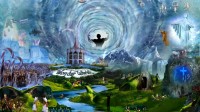MARCO BRAMBILLA
Civilization
source: marcobrambilla
Civilization is a multi-layered tableau of interconnecting images that illustrates a contemporary, satirical take on the concepts of eternal punishment and celestial reward. More than 300 individual channels of looped video are blended into an expansive landscape that continuously scrolls upward, from the depths of hell to the gates of heaven.
.
.
.
.
.
.
.
source: fastcocreate
Marco Brambilla was a middling commercial and TV director until 1993, when he finally got a break as director of the Sylvester Stallone action flick Demolition Man. After that, he quit.
It wasn’t something Sly said. “I’m a huge cinemaphile. My interest in filmmaking came out of experimenting with different genres, and I wanted to go back to working in a way that was more personal, which, for me, was artwork. Commercials and films are more collaborative,” Brambilla tells Fast Company.
So, buoyed by savings, Brambilla dove back into his experimental roots. He began playing with film montages, compositing, and genre mash-ups, marrying cinematic technology, photographic, and painting concepts. “Thematically, most of my work deals with transition, our culture’s constant acceleration, and emotional connection and disconnection through technology,” Brambilla says. The mainstream came calling him again in 2009, when the Standard Hotel in New York unveiled his “Civilization”–a hell-to-heaven ascent through intricate layers of superimposed film loops collectively satirizing pop iconography–on permanent display … in the hotel elevator.
The following year, Brambilla made a bigger splash with a Baroque-styled mini-video for Kanye West’s “Power.”
At age 50, he is enjoying his first retrospective, Marco Brambilla: The Dark Lining at the Santa Monica Museum of Art in Santa Monica, California, which through August 20, is presenting seven installations that mark his artistic evolution from 2001 to the present. “Sea of Tranquility” is a computerized time-lapse fictional decay of the Apollo 11 Lunar Module and American flag on the moon, a poignant statement on the collapse of American idealism.
“HalfLife” juxtaposes zombified teens staring into a video game console, inured to the game’s violent images, which stream on adjacent walls.
The exhibit builds to 3-D versions of “Civilization” and “Evolution,” an equally ambitious moving composition wryly suggesting that humans have learned little more than how to spectacularly slay one another. If it weren’t for Brambilla’s subversive sense of humor woven throughout the imagery, you’d think he thought mankind was facing impending doom.
Brambilla’s satirical sensibility springs from his multicultural life. He grew up in Italy and Canada, where he began making Super 8 films as a teen and later studied filmmaking at Ryerson University in Toronto. He now divides his time between New York and Los Angeles (where he is represented by the Christopher Grimes Gallery), and soon, Berlin, where he’s opening a new studio. “Not growing up in America enabled me to look at and deconstruct it from the outside,” he says.
The evolution of technology has opened the door for increasingly ambitious projects. “The process significantly changed in the last five years,” he says. “When I first started, before I’d shoot a video installation, I’d use a camcorder to map out what I wanted, then edit it together. The final part of the process had to be done with a post-production company. It was a much bigger process. Now, the technology is at the stage where I can shoot, edit and post-produce it on my laptop. I use a compositing tool called Flame [an Autodesk product]. The last part of the process, involving 3-D, is done at a facility.” (“Civilization” was completed at The Vanity in Toronto; “Evolution” at the New York offices of The Mill.) “Now, I can experiment in a way I could never do even a few years ago, and make something in video more akin to painting and sculpture.”
Brambilla’s next project, which he expects to finish in October and premiere at shows in London and New York, is another epic, themed, three-minute video collage. But this is involving original photography and conceived from the beginning in 3-D, as opposed to converting 2-D images, which will allow him to creating a greater sense of depth.
“From my experience working in commercial film, I’m able to use technology that most artists don’t really use and have access to people who are really good with it,” he says. “I never intended to become a commercial filmmaker in the first place. What I do requires time and experimentation. Commercial work is often not the best way to get the most innovative work, because it’s about money and marketing. Although advertising is now embracing non-commercial people. They’re finding that having something innovative is a more unusual way to stand out.”


